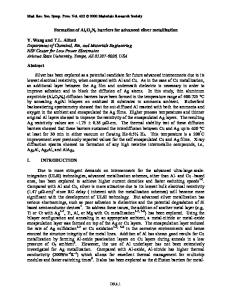Anti-diffusion barriers for gold-based metallization to GaN
- PDF / 350,633 Bytes
- 6 Pages / 612 x 792 pts (letter) Page_size
- 19 Downloads / 300 Views
0892-FF14-05.1
Anti-diffusion barriers for gold-based metallizations to p-GaN A. Piotrowska1, E. Kaminska1, M. Guziewicz1, E. Dynowska2, A.Stonert3, A. Turos3,4, S. Figge5, R. Kröger5, and D. Hommel5 1
Institute of Electron Technology, Al. Lotnikow 32/46, 02-668 Warsaw, Poland Institute of Physics PAS, Al. Lotnikow 32/46, 02-668 Warsaw, Poland 3 Institute of Nuclear Problems, ul. Hoza 69, Warsaw, Poland 4 Institute of Electronic Materials Technology, ul. Wolczynska 133, 01-919 Warsaw, Poland 5 University of Bremen, Institute of Solid State Physics, Otto-Hahn-Allee NW1, D-28359 Bremen, Germany 2
ABSTRACT We propose a new metallization scheme to p-GaN, where thin-film transition metal nitrides have been applied to improve thermal stability of gold-based metallization. In this metallization scheme the Pd/Au bilayer was used to form low-resistivity ohmic contact to p-GaN, while Ta-Si-N, Ti-Si-N, and Ti-W-N anti-diffusion barriers were used to protect contact metallization from interaction with Au overlayer. We present the details of optimization of process parameters of barrier layer fabrication and show that Ta0.34Si0.25N0.41 and Ti0.26Si0.0.17N0.57 thin films fabricated by reactive magnetron sputtering show excellent barrier properties under high temperature stress. INTRODUCTION Great interest exists in GaN and related materials since the successful demonstration of optoelectronic devices operating at short wavelengths such as blue and green LEDs and LDs. The formation of stable and reliable ohmic contacts has been a problem in achieving good performance of these devices. This is especially true for p-type ohmic contacts for LDs where high current levels are required and where internal heating still limits their output power and lifetime. To date, there have been basically two approaches to obtain low resistance ohmic contact to p-type GaN [1]. The first one was to optimise the properties of semiconductor sub-contact region; either by increasing Mg doping during the p-GaN growth or by applying an additional semiconductor structure such as p-AlGaN/p-GaN superlattice [2], p-InGaN/p-GaN superlattice [3], or single-layer low-band-gap p-InGaN [4]. The second one is to optimise contact metallizations itself: choice of material, procedure of semiconductor surface pre-treatment, the parameters of metal deposition and post-deposition heat treatment (temperature, time, atmosphere) [5, 6]. Au and Au-based alloys/multilayers remain the most commonly applied materials for metallization systems in GaN-based device technology. These include making ohmic contacts as well as metal overlayers for bonding and interconnection purposes. In particular, Au-based metallizations such as NiAu or PdAu metallization have been proven to give low resistivity ohmic contact to p-GaN lacking however stability at elevated temperatures [7]. In this work an approach has been undertaken to solve this problem by using antidiffusion barriers. To be applicable, these thin-film materials must fulfil specific requirements of: high thermal stability, high e
Data Loading...











